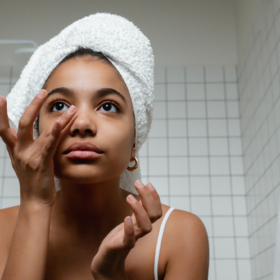
BV or thrush? What’s the Difference?
In this article
What's the lowdown?
Bacterial Vaginosis (BV) and thrush are both vaginal infections, not sexually transmitted infections (STIs)
You may experience vaginal discharge with both BV and thrush
They both occur due to the imbalance of bacteria in our vaginal microbiome
BV and thrush are both vaginal infections and can lead to some funny-looking discharge. Don’t worry it’s not a major infection, just very annoying. Talk about an uninvited guest!
Bacterial Vaginosis (BV)
BV is one of the most common infections in women. While it is not an STI, it can be triggered by sex, new sexual partners and incorrect condom use. We’re not quite sure why people get BV (yes, again we don’t know, women’s health research etc etc) but it is associated with the overgrowth of certain bacteria in our vagina.
Symptoms of BV include1:
- Vaginal discharge that smells fishy in nature
- Grey-white looking discharge
- Discharge is more thin and watery
50% of women do not actually have any symptoms1.
Thrush
Thrush (medically known as candidiasis) occurs when there is an overgrowth of a fungal species called Candida, predominantly Candida Albicans. You can also have thrush in your mouth so vaginal thrush is called vulvovaginal candidiasis. You will find Candida in a normal healthy vagina, but it is kept within limits by a good bacteria species called lactobacilli.
When this fungus overgrows, it can lead to symptoms of:
- White fluffy or thick cottage-cheese-like discharge
- Vaginal/vulval itching and irritation
- Vulval redness (might not be visible on some darker skin types)
- Painful sex
- Stinging when peeing
Can you have BV and thrush at the same time?
As they are both caused by the overgrowth of different types of microbes, you can have BV and thrush at the same time. Though this is quite uncommon. A study found that 20-30% of people had a co-infection of BV and thrush2.
Causes of BV or Thrush
These infections are not sexually transmitted. It is usually linked to your vaginal microbiome. Your vagina has its own ecosystem of healthy bacteria, mainly dominated by good bacteria called lactobacilli. When there is an imbalance in these bacterial concentrations, infections like BV and thrush can take over. Your vagina is naturally acidic, with a pH (measure of acidity) between 3.8 to 4.5. This low pH environment prevents unwanted bacteria from flourishing and causing these types of infections4.
There are multiple risk factors for BV1:
- Smoking
- Having sex
- Not using a condom
- Scented products and vaginal douching
- Having a new sexual partner
- Having multiple sexual partners
There are also multiple risk factor for thrush2:
- Damaged or irritated skin
- Diabetes
- Antibiotics
- Hormonal contraceptives
- Hormone replacement therapy
- Weakened Immune System
- Pregnancy
- Menstruation
We delve into more detail about the causes of BV and causes of thrush in separate articles.
Diagnosing Thrush or BV
BV and thrush are diagnosed similarly. If it’s the first time you’ve had symptoms, you should have a vaginal swab. These can be performed by your healthcare professional at your GP surgery, local sexual health clinic or you can do them yourself at home. The swab is looked at under a microscope to confirm the diagnosis5,6.
If you have recurrent symptoms, and have had BV or thrush confirmed by a swab before, you may not need an examination. However, if you’re getting symptoms over and over again, please see someone to make sure you’re not missing an underlying condition with similar symptoms, like lichen sclerosus or an STI.
If you have symptoms of vaginal discharge or itch, you can get help and diagnosis from your GP or at a sexual health clinic. Although thrush and BV aren’t STIs, sexual health clinicians are experts in their diagnosis and treatment and can also perform a full sexual health check.
BV and thrush treatment
Your vagina is an amazing organ! It, like most of us, is strong and independent. So this means most of the time, your vagina can clear BV and thrush on its own. But sometimes, like most of us, we need a little helping hand. Untreated BV can lead to conditions like pelvic inflammatory disease.
BV can be treated with antibiotics, either oral as tablets or vaginally as a gel, which are prescribed by a healthcare professional. Be sure to let your clinician know if you are pregnant or breastfeeding as it can change the treatment5. BV can also be treated with vaginal gels which contain lactic acid that helps the vaginal microbiome to rebalance itself – these are not antibiotics.
Thrush is treated with antifungals, because it is caused by a fungus. This antifungal can be prescribed as a cream, pessary (tablet that goes into the vaginal), oral capsule or a combination of these. Again if you are pregnant, please let your healthcare provider know as it can change treatment plans6.
If you are taking medication to clear BV or thrush please make sure to finish the full course to prevent recurrence!
You can buy lactic acid BV gels and thrush treatment over the counter from pharmacies without a prescription. However, BV antibiotics do need a prescription.
Tips to prevent BV and Thrush
These tips are not just great for preventing infections but also for optimising vaginal health6:
- Avoid using scented soaps as fragrances can irritate the skin
- Ensure your vulval area is dry after washing (as moisture causes bacteria and fungus to thrive)
- Wear loose cotton clothes
- Avoid having sex until the infection is cleared up
- Cut down on smoking (not just for your vagina but also for your lungs)
- Use barrier protection properly
- Have regular sexual health checks if you have a new or multiple partners
Difference between thrush and BV
Thrush and BV are separate infections, with different causes that we’ve discussed above. Both of them cause vaginal discharge. The discharges are distinctive and can differentiate between the two infections. BV discharge is thin, watery, grey and might smell fishy, whereas thrush discharge is thick, white and itchy.
No one likes an infection, especially in their vagina. Vaginal infections are not embarrassing, just unnecessary!
Fingers crossed it clears up on its own quickly, but sometimes infections are stubborn. If your symptoms persist for over 3 days or the other symptoms become unbearable, get some treatment. You can either visit your pharmacy, book an appointment with a sexual health clinic or with a GP such as a Lowdown GP!
You have questions, we have answers (and treatments)!
Our medical review process
This article has been medically reviewed for factual and up to date information by a Lowdown doctor.



